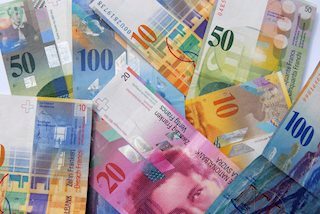USD/CHF tumbles below 0.8600 as US Dollar weakens further
|
- USD/CHF slides below 0.8600 amid weakness in the US Dollar.
- Investors want to know how much the Fed will reduce interest rates in September.
- Market participants should brace for high volatility amid an eventful US week.
The USD/CHF pair faces an intense sell-off and slides below the round-level support of 0.8600 in Tuesday’s North American session. The Swiss Franc asset plummets as the US Dollar (USD) has declined to a multi-month low as investors seemed to be strongly confident that the Federal Reserve (Fed) will start reducing interest rates from the September meeting.
Market sentiment is favorable for risky assets on Fed potential rate cuts in September. The S&P 500 has opened on a positive note, exhibiting further improvement in investors’ risk appetite. The US Dollar Index (DXY), which tracks the Greenback’s value against six major currencies, slumps to near 101.65, the lowest level seen in more than seven months.
This week, investors should brace for more volatility as the Federal Open Market Committee (FOMC) minutes and the preliminary United States (US) S&P Global PMI for August are lined up for release. However, investors will majorly focus on Fed Chair Jerome Powell’s speech at the Jackson Hole (JH) Symposium on August 22-24.
Investors would look for cues about how much the Fed will cut interest rates in September and the entire year. According to the CME FedWatch tool, 30-day Federal Finds Futures pricing data shows that the likelihood of 50 basis points (bps) interest-rate reduction has diminished to 26.5% from 53%, recorded a week ago.
In the Swiss region, market participants want to see more cues about whether the Swiss National Bank (SNB) will continue its policy-easing cycle in September. The SNB has already reduced interest rates by 50 basis points (bps) to 1.25% this year.
US Dollar FAQs
The US Dollar (USD) is the official currency of the United States of America, and the ‘de facto’ currency of a significant number of other countries where it is found in circulation alongside local notes. It is the most heavily traded currency in the world, accounting for over 88% of all global foreign exchange turnover, or an average of $6.6 trillion in transactions per day, according to data from 2022. Following the second world war, the USD took over from the British Pound as the world’s reserve currency. For most of its history, the US Dollar was backed by Gold, until the Bretton Woods Agreement in 1971 when the Gold Standard went away.
The most important single factor impacting on the value of the US Dollar is monetary policy, which is shaped by the Federal Reserve (Fed). The Fed has two mandates: to achieve price stability (control inflation) and foster full employment. Its primary tool to achieve these two goals is by adjusting interest rates. When prices are rising too quickly and inflation is above the Fed’s 2% target, the Fed will raise rates, which helps the USD value. When inflation falls below 2% or the Unemployment Rate is too high, the Fed may lower interest rates, which weighs on the Greenback.
In extreme situations, the Federal Reserve can also print more Dollars and enact quantitative easing (QE). QE is the process by which the Fed substantially increases the flow of credit in a stuck financial system. It is a non-standard policy measure used when credit has dried up because banks will not lend to each other (out of the fear of counterparty default). It is a last resort when simply lowering interest rates is unlikely to achieve the necessary result. It was the Fed’s weapon of choice to combat the credit crunch that occurred during the Great Financial Crisis in 2008. It involves the Fed printing more Dollars and using them to buy US government bonds predominantly from financial institutions. QE usually leads to a weaker US Dollar.
Quantitative tightening (QT) is the reverse process whereby the Federal Reserve stops buying bonds from financial institutions and does not reinvest the principal from the bonds it holds maturing in new purchases. It is usually positive for the US Dollar.
Information on these pages contains forward-looking statements that involve risks and uncertainties. Markets and instruments profiled on this page are for informational purposes only and should not in any way come across as a recommendation to buy or sell in these assets. You should do your own thorough research before making any investment decisions. FXStreet does not in any way guarantee that this information is free from mistakes, errors, or material misstatements. It also does not guarantee that this information is of a timely nature. Investing in Open Markets involves a great deal of risk, including the loss of all or a portion of your investment, as well as emotional distress. All risks, losses and costs associated with investing, including total loss of principal, are your responsibility. The views and opinions expressed in this article are those of the authors and do not necessarily reflect the official policy or position of FXStreet nor its advertisers.